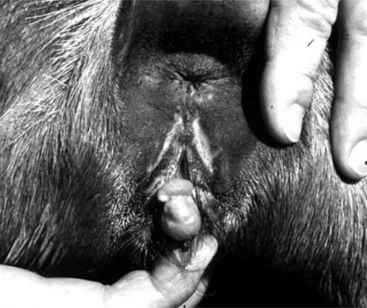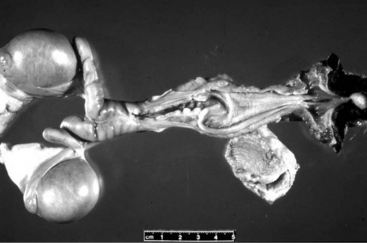Chapter 20 Congenital Anomalies in the Sheep and Goat
Numerous congenital abnormalities have been reported in both sheep and goats. As in other species, these abnormalities generally result from a genetic defect (spontaneous or inherited) or an in utero environmental exposure of the fetus. Included in the list of recognized environmental causes are a number of viruses, toxic plants, and teratogenic drugs. With the exception of congenital defects involving the genital organs, very little research into the chromosomal genetics of defects has been conducted. In many cases, the genetic basis of a defect is founded on the increased incidence or expression of the defect in a given family of animals. When the defect involves the genitalia of the animal (particularly the external genitalia), then alteration in its ability to mature and reproduce often leads to an increased recognition of the abnormality. A defect that involves a specific enzyme deficiency is much more difficult for a breeder to recognize and thus may not be identified as a congenital problem. For the purposes of this chapter, we will focus on two of the more commonly recognized genital abnormalities of sheep and goats.
Intersex
The intersex congenital abnormality involves the presence of both male and female characteristics in the same animal (Figure 20-1). A variety of presentations can be seen. When female and male gonads are both present, this intersex condition is called hermaphrodite. When the gonads of one sex are present with the phenotype of the opposite sex, this condition is called pseudohermaphrodite (Figure 20-2); a male pseudohermaphrodism has the male gonads, whereas the female has the female gonads. Although the condition of intersex is recognized in both sheep and goats, the incidence is highest in the goat species, whose genetics has been extensively studied. The incidence of the intersex condition is higher in polled goats. Animals that are polled (congenital absence of horns) have the dominant mutation of the polled gene coded at the horn locus. Thus the mutated gene (P) in either a homozygous (PP) or heterozygous (PP) state codes for a polled animal, and the homozygous recessive state (pp) codes for horns. Because many breeders would prefer to have polled kids that do not require disbudding or dehorning, various attempts have been made to breed polled animals. However, it appears that the polled locus is in close proximity to a gene that effects sexual differentiation. This autosomal gene has functions similar to a Y chromosome, thereby inducing masculinization. As such, females (XX) that are homozygous for the polled gene have the intersex condition (female pseudohermaphrodite), and the males are predisposed to stenosis of the epididymis. No such association has been reported in polled sheep.

Figure 20-1 Vulva of a goat; note vestigal penis typical of a female pseudohermaphrodite.
(Courtesy of Dr. John King; Cornell University.)
Stay updated, free articles. Join our Telegram channel

Full access? Get Clinical Tree



